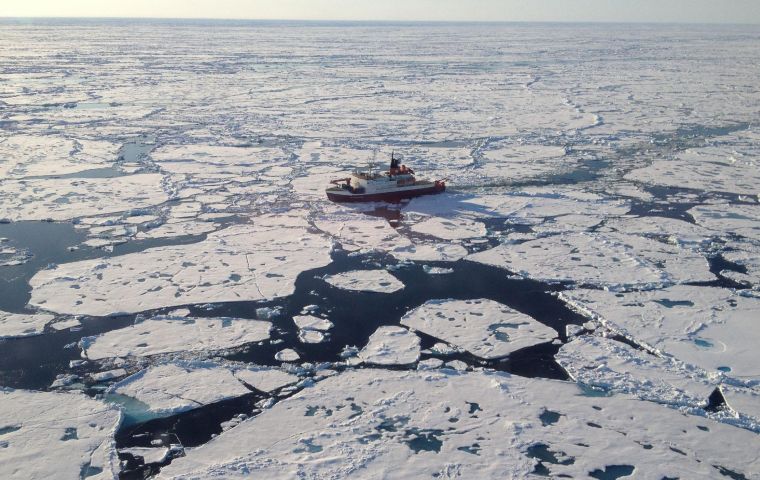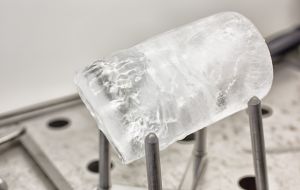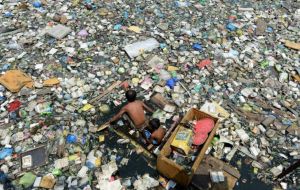MercoPress. South Atlantic News Agency
Tons of frozen micro-plastics found trapped in the floating ice of the Arctic
 Traces of 17 different types of plastic were found in frozen seawater. Micro-plastics are tiny plastic pieces under five millimeters long.
Traces of 17 different types of plastic were found in frozen seawater. Micro-plastics are tiny plastic pieces under five millimeters long.  A considerable amount of micro-plastic is released directly into the ocean by the gradual breakdown of larger pieces of plastic.
A considerable amount of micro-plastic is released directly into the ocean by the gradual breakdown of larger pieces of plastic.  “Plastic fingerprint” suggests they were carried on ocean currents from the huge garbage patch in the Pacific or arose locally due to shipping and fishing pollution
“Plastic fingerprint” suggests they were carried on ocean currents from the huge garbage patch in the Pacific or arose locally due to shipping and fishing pollution Record levels of micro-plastics have been found trapped inside sea ice floating in the Arctic. Ice cores gathered across the Arctic Ocean reveal micro-plastics at concentrations two to three times higher than previously recorded. As sea ice melts with climate change, the plastic will be released back into the water, with unknown effects on wildlife, say German scientists.
Traces of 17 different types of plastic were found in frozen seawater. Micro-plastics are tiny plastic pieces under five millimeters long. They can be eaten by filter-feeding animals and passed up the food chain.
A considerable amount of micro-plastic is released directly into the ocean by the gradual breakdown of larger pieces of plastic. But micro-plastics can also enter the sea from health and beauty products, washing synthetic textiles or abrasion of car tyres.
Their “plastic fingerprint” suggests they were carried on ocean currents from the huge garbage patch in the Pacific Ocean or arose locally due to pollution from shipping and fishing.
More than half of the micro-plastic particles within the ice were so small that they could easily be ingested by sea life, said Ilka Peeken of the Alfred Wegener Institute, Helmholtz Centre for Polar and Marine Research in Bremerhaven, Germany, who led the study.
“No one can say for certain how harmful these tiny plastic particles are for marine life, or ultimately also for human beings,” she said.
The ice cores were gathered from five regions throughout the Arctic Ocean in the spring of 2014 and summer of 2015. They were taken back to the laboratory, where they were analyzed for their unique plastic “fingerprint”.
“Using this approach, we also discovered plastic particles that were only 11 micrometers across,” said co-researcher Gunnar Gerdts, also from the Alfred Wegener Institute.
“That's roughly one-sixth the diameter of a human hair, and also explains why we found concentrations of over 12,000 particles per liter of sea ice - which is two to three times higher than what we'd found in past measurements.”
The researchers found a total of 17 different types of plastic in the sea ice, including packaging materials like polyethylene and polypropylene, but also paints, nylon, polyester, and cellulose acetate (used to make cigarette filters).
They say the plastic found its way to the Arctic Ocean from the huge garbage patch in the Pacific Ocean or from ship's paint and fishing nets.
“These findings suggest that both the expanding shipping and fishing activities in the Arctic are leaving their mark,” said Dr Peeken.
“The high micro-plastic concentrations in the sea ice can thus not only be attributed to sources outside the Arctic Ocean. Instead, they also point to local pollution in the Arctic.”
Estimates suggest about eight million tons of plastic move from the land into the ocean every year, with some finding its way into remote areas, such as the Polar Regions and the deep ocean floor.


Top Comments
Disclaimer & comment rulesCommenting for this story is now closed.
If you have a Facebook account, become a fan and comment on our Facebook Page!